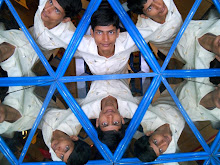Flying unmanned aircraft over war zones may seem to outsiders like playing a tricked-out video game.
But these operations can be, indeed, dangerous, a panel of aviators said this week at an Army conference. Bad weather, makeshift runways and close calls with friendly helicopters are among the hazards that put both aircraft and pilots at risk.
Several unmanned aircraft operators — speaking at the Army Aviation Association of America’s annual symposium outside Washington, D.C. — said the learning curve for mastering the use of drones was steep. It has taken years of combat experience to achieve proficiency, they said.
“One of the first brigades that we worked for didn’t really seem to know how to use it [the aircraft], so we were pretty much just burning holes in the sky,” said Sgt. 1st Class Kelly C. Boehning, who was named unmanned aerial systems (UAS) "soldier of the year" at the symposium.
Enemy fighters both in Iraq and Afghanistan caught on quickly, timing their attacks based on U.S. flying schedules, said Staff Sgt. Frank C. Petersen, a UAS instructor at Fort Huachuca, Ariz. “I can’t say that they figured out what our weather limitations were, but they definitely could tell when we were or weren’t flying,” he said.
Many weather events can keep drones on the ground — high winds, lightning, freezing temperatures. “When there was bad weather, it seemed like there was always an increase in rocket fire or mortar attacks,” Boehning said. “I think they knew when we weren’t flying. I think it’s pretty obvious.”
Boehning described a typical scenario. "Basically you look at a field for hours and hours and hours and hours, waiting for something to happen,” he explained. “It’s not very exciting, but when you finally see a flash off in the distance, you zoom in and see some guys shooting mortars. You immediately yell out the grid [location], send it to the fires people and then you wait. Then you see the artillery come down and destroy the mortar team. It’s like Monday Night Football. It’s the big-screen TV and everybody jumps up and kicks their chairs over. You know you probably saved somebody’s life.”
Unlike Air Force operators who fly drones in theater from locations in the United States, the Army deploys its UAS pilots overseas with the ground troops they support. Whether keeping watch over a convoy or raid, there is an added incentive for operators to bring their comrades back “into the gate” safely, said Boehning. “We watched trucks roll out of the gate that morning and we were watching them on the video screen that afternoon,” he said. “We knew the people we were watching. We knew where they were going to go, we knew the neighborhoods, we knew some of the street names, we knew some of the people by name. I think that personal touch was very important. It made us feel like part of the fight as opposed to being remotely located, especially in Las Vegas or something, watching the fight.”
Another challenge for the crews was finding suitable locations to set up UAS bases of operation. Boehning said his unit was lucky enough to find an airfield that once was used by the Iraqi Air Force. It came with everything they needed and more, including a hard runway and a communications tower.
Another unit was not so fortunate. After being kicked off one airfield, it found another with a nice runway and seemingly solid facilities. After about a month, though, the hangars collapsed on the U.S. aircraft that had been stored inside.
In the schoolhouse, Army UAS operators are taught that they need an area the size of a soccer field to launch and land their Shadow unmanned aircraft. Boehning never imagined falling into readymade facilities. “If we had gone over to a country without any runways or airports or anything to use, we would have just done what the system was advertised to do.” That would require blocking off streets to create landing strips or hauling dirt from one area to another to build a runway, as some units have done.
“That’s what we expected in the beginning,” Boehning said. “Now I think we’re all used to having fixed facilities, so I think we’re all probably spoiled.”
Thursday, March 24, 2011
Army Pilots: Flying Drones Is Harder Than It Looks
Subscribe to:
Post Comments (Atom)




0 comments:
Post a Comment